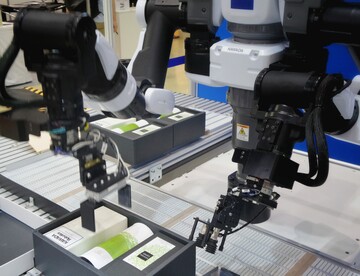What are some uses for electromagnets?

Electromagnets are used in robots to pick up and move objects.

Electromagnets are used in robots to pick up and move objects.
Electromagnets are magnets that are created when electricity flows through a coil of wire. The coil of wire is wrapped around a metal core, such as iron. When the electricity flows, it creates a magnetic field around the coil. The strength of the magnetic field depends on the amount of electricity flowing through the coil.
There are many uses for electromagnets. Here are a few examples:
- Bells: Electromagnets are used in doorbells and electric bells. When the doorbell button is pressed, it completes an electrical circuit, which causes the electromagnet to turn on. The electromagnet then attracts a metal clapper, which strikes the bell, making a sound.
- Magnetic locks: Electromagnets are used in magnetic locks. These locks are used to keep doors closed. When the door is closed, the electromagnet is turned on, which attracts a metal plate. This keeps the door closed. When the door is opened, the electromagnet is turned off, and the metal plate falls away, allowing the door to open.
- Sorting machines: Electromagnets are used in sorting machines to separate metal objects from other materials. For example, an electromagnet can be used to separate iron and steel from other materials in a recycling plant.
- MRI machines: Electromagnets are used in MRI machines to create images of the body. MRI machines use a very strong electromagnet to create a magnetic field around the body. This magnetic field causes the body's atoms to align themselves in a specific way. When the magnetic field is turned off, the atoms release energy, which is detected by the MRI machine and used to create images of the body.
Electromagnets are very useful devices. They are used in a wide variety of applications, from doorbells to MRI machines. Electromagnets are a great example of how electricity and magnetism can be used to create useful devices.
How does an electromagnet work?
An electromagnet works by using electricity to create a magnetic field. It is like a regular magnet, but it can be turned on and off using electricity. When we pass electricity through a coil of wire that is wrapped around a metal core, like iron, it creates a magnetic field. The strength of the magnetic field depends on how much electricity is flowing through the wire.
Let me help you understand with an example. Imagine you have a long, thin piece of wire and you wrap it around a nail. Now, if you connect the ends of the wire to a battery, electricity will start flowing through the wire. This electricity creates a magnetic field around the wire and the nail becomes magnetized. It becomes a temporary magnet. But as soon as you disconnect the wire from the battery, the nail will no longer be magnetized. So, you can turn the magnet on and off by using electricity.
Electromagnets are very helpful in our everyday lives. We use them in things like doorbells and electric bells. When someone presses the doorbell button, it completes a circuit that allows electricity to flow through the coil of wire. This activates the electromagnet and attracts a metal clapper to strike the bell and make a sound.
Can you give me more examples of how electromagnets are used in our daily lives?
Electromagnets are used in many things we use every day. Here are a few more examples:
- Speakers: Electromagnets are used in speakers to make sound. When you listen to music or watch a movie, the electrical signals from your device go through a coil of wire in the speaker. This creates a magnetic field, which interacts with a permanent magnet and makes the speaker cone move back and forth, producing sound.
- Electric motors: Electromagnets are also used in electric motors. Electric motors are found in things like fans, washing machines, and cars. They work by having an electromagnet spin inside another permanent magnet. The magnetic force between the two magnets makes the electromagnet spin, which allows the motor to do useful work.
- Maglev trains: Electromagnets are used in Maglev trains, which are super-fast trains that float above the tracks using magnetic levitation. The trains have powerful electromagnets on the bottom that are attracted to magnets in the tracks. This magnetic attraction lifts the train off the ground, reducing friction and allowing it to move smoothly and quickly.
These are just a few more examples of how electromagnets are used in our daily lives. They show how electricity and magnetism can work together to make our world more convenient and exciting.
How are electromagnets used in recycling?
Electromagnets are used in recycling to separate metal objects from other materials. When we recycle things like cans or old appliances, there might be other materials mixed in with the metal, like plastic or paper. To separate the metal, sorting machines use powerful electromagnets.
Let's say we have a big pile of mixed-up materials at a recycling plant. When the pile goes through the sorting machine, the electromagnet turns on and creates a strong magnetic field. Since metal is attracted to magnets, the electromagnet attracts all the metal objects, like cans or screws.
As the pile moves forward, the electromagnet drops the metal objects into a separate container, leaving behind the other materials. This way, the metal can be easily separated and recycled.
So, electromagnets help us in recycling by sorting out valuable metals from other materials, making recycling more efficient and reducing waste.

Electromagnets are used in robots to pick up and move objects.